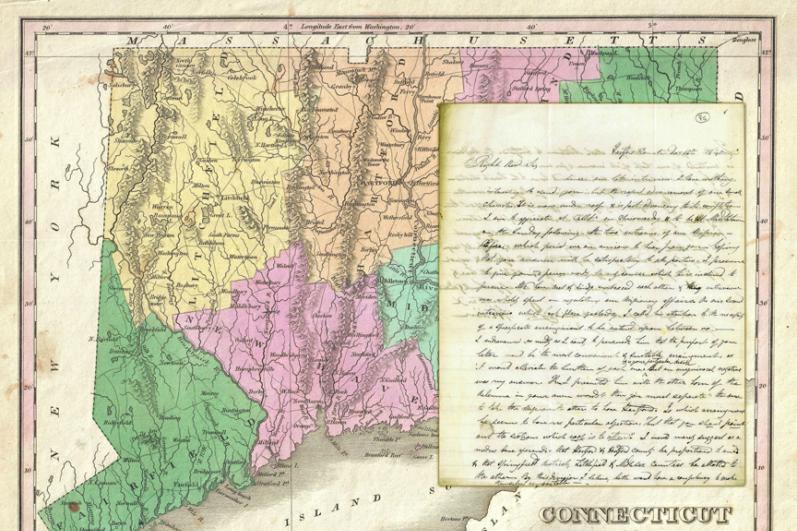Challenges of ministering to the far-flung parishes of the Diocese of Boston
A letter in the Bishop Benedict Fenwick papers, written by Father James Strain from Hartford, Connecticut, on Dec. 16, 1840, continues an ongoing discussion about how best to serve Catholics in the western portions of Massachusetts and Connecticut.
In 1840, the Diocese of Boston still encompassed all New England. About one decade earlier, Connecticut had been made the responsibility of a mission based in Pawtucket and Providence, Rhode Island, but by this time was divided into three sections.
The first, listed in the Catholic almanac as being based in New London and Norwich, probably included all or most of Tolland, Windham, and New London counties; roughly the eastern third of the state. This area was the responsibility of the priest assigned to Worcester, Father James Fitton.
There was a parish in New Haven assigned to Father James Smyth, who also oversaw a mission at Bridgeport and most likely Catholics in Fairfield and New Haven counties.
And, finally, a parish in Hartford oversaw missions in Cabotville (Chicopee) and Springfield, Massachusetts, as well as Middletown, Connecticut. The territory it encompassed was enormous, including the Connecticut counties of Hartford, Litchfield, and Middlesex, and its priests were known to have visited portions of Hampden, Hampshire, Franklin, and Berkshire counties in Massachusetts.
In his December 1840 letter to Bishop Fenwick, Father Strain alludes to previous discussions held between the two regarding the possibility of reconfiguring the territory assigned to Hartford. To illustrate the need, he explains the expectation that he celebrate Mass on Christmas Day in Cabotville (Chicopee) and the following Sunday be in Middletown, Connecticut; the two extreme limits of the parish, nearly 50 miles apart.
He references a solution the two had discussed for dividing the large parish, to which Father Brady disagreed, and that he proposed a second solution that received a more favorable response. The second proposal was for the priest based in Hartford to be responsible for serving Catholics in Hartford County, and the other to oversee the missions around Springfield, as well as Catholics in Litchfield and Middlesex Counties in Connecticut; north, west, and south of Hartford County, respectively. "By this division," he writes, "I believe both would have a competency to make themselves comfortable."
This phrase refers to the number of Catholics in each of those defined areas and, specifically, if those numbers are able to financially support a priest.
He continues: "In the supposition that you attached Middletown to Hartford, the mission is curtailed by one half of its income and for one to obtain a livelihood Northampton (Mass.) or some other district could have to be there to attached, and by this arrangement Hartford is deprived of Mass once a month and I consider the Hartford congregation sufficiently able to support their clergyman."
He closes by telling Bishop Fenwick that "your voice is only required to set all things right, whatever positions falls to my lot I am satisfied," and urges him to reply quickly as it is hoped any changes can take effect before Christmas.
Evidence suggesting that such a division took place has not been forthcoming and, in any event, Father Strain was reassigned to St. Mary in Salem the following year. As with Hartford, the position included all Catholics in the surrounding area, including missions in Gloucester, Ipswich, and Lynn.
The "History of the Archdiocese of Boston" describes Father Strain as an "unfortunate priest, whose ministry in many places was blighted by his mistakes of judgment and by undue hastiness in word and action." At St. Mary, Salem, he came into conflict with his parishioners and had to be reassigned to St. Mary, Waltham, only for the same scenario to cause his reassignment to St. Mary, Boston, and again then to familiar territory in Cabotville (Chicopee) in 1847. By 1850, he again provoked the ire of parishioners and left the mission.
Though his inability to live harmoniously with his parishioners is well accounted for, it is believed he is due "credit for his restless energy and far-flung activities." In addition to serving the missions in western Massachusetts and Connecticut, while serving as the pastor in Waltham he would travel to Catholics as far away as Nantucket.
Meanwhile, Bishop Fenwick would soon be relieved of caring for Connecticut Catholics. The Diocese of Hartford was established on Nov. 28, 1843, comprising the states of Connecticut and Rhode Island, with Father William Tyler, vicar general of the Diocese of Boston, as its first bishop. As a result, the Diocese of Boston was reduced in size to the states of Massachusetts, Maine, New Hampshire, and Vermont.
This document provides a glimpse into some of the difficulties Boston's earliest bishops faced while ministering to Catholics in such a large diocese. With so few priests, an assignment for Father Strain had to be found despite his inability to forge amicable relations with his parishioners. Additionally, those priests who did were responsible for an expansive territory, often attending to several missions, and overseeing a vast parish, while moving at the speed of 19th century travel. And, finally, the ability of the local Catholics to support a priest, and/or the construction of a church, had to be considered.
- Thomas Lester is the archivist of the Archdiocese of Boston.



















